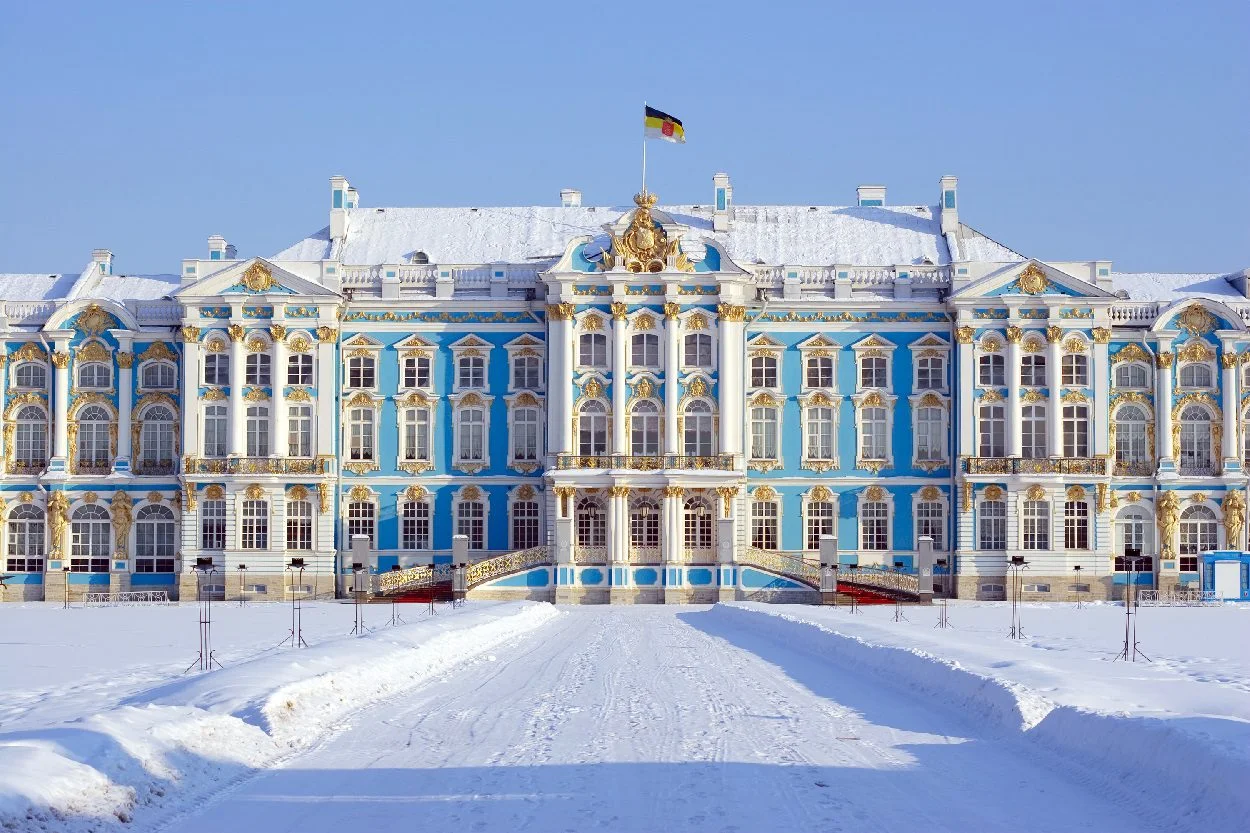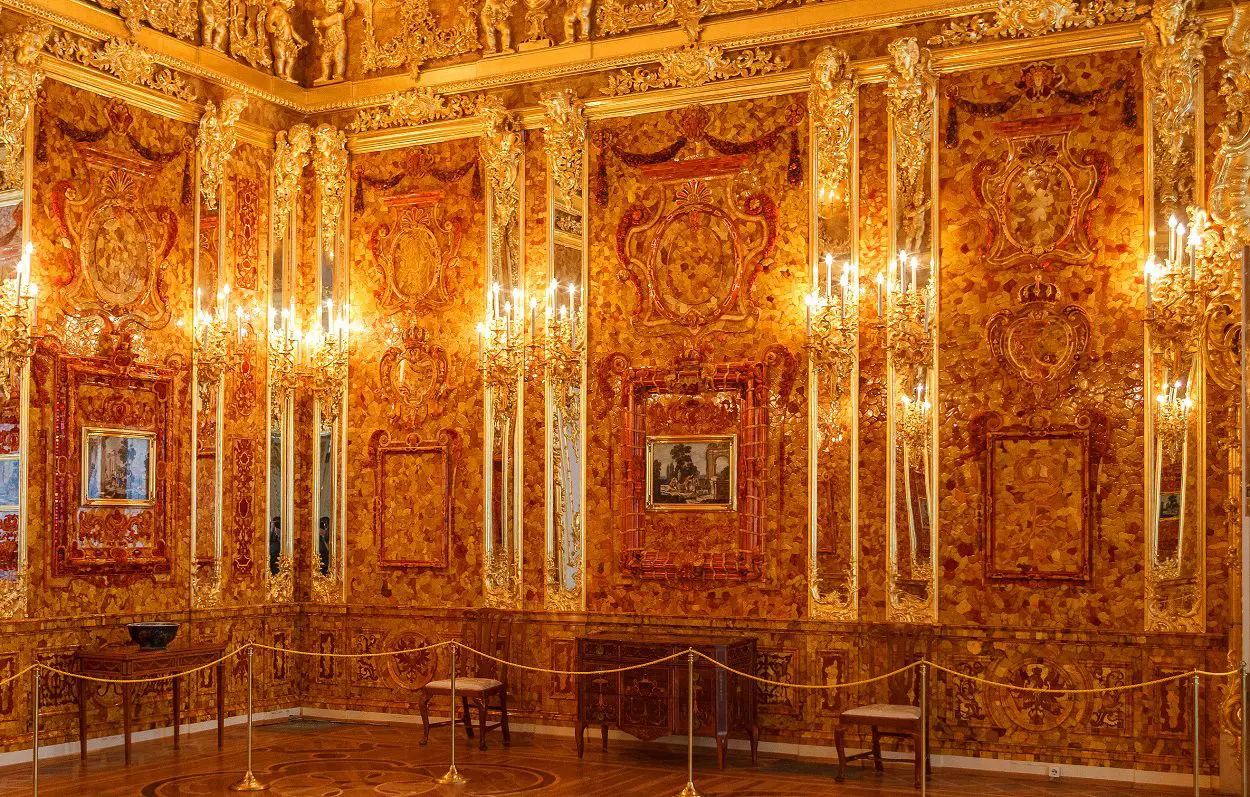The Amber Room, often referred to as the “Eighth Wonder of the World”, was one of Russia’s most priceless works of art until it was looted by Nazi Germany and lost after the conclusion of WW II.
The Amber Room was designed for Charlottenburg Palace by Andreas Schlüter, a German baroque sculptor and renowned architect. Construction began in 1701 by master craftsman Gottfried Wolfram and amber masters Ernst Schacht and Gottfried Turau.
Although meant for Charlottenburg, the Amber Room was installed at the Berlin City Palace, where it was admired by Peter the Great of Russia during a state visit in 1716. In order to forge a Russo-Prussian alliance against Sweden, Frederick William I gifted the Amber Room to the Russian Empire to cement their new relationship.
Over a period of ten years, the Amber Room was reworked and installed at the summer home of the Imperial family at Catherine Palace in modern-day Pushkin, just outside of St. Petersburg. Its surface covered more than 55 square metres with over 6 tonnes of amber, that today has a monetary value of around £240 million.

The room contained ornate architectural features, such as gilding, carvings, amber panels, gold leaf, gemstones, statues of angels and children, and mirrors that illuminated the room with candle light.
During WW II, the German invasion of the Soviet Union (otherwise known as Operation Barbarossa) placed cultural works of art under threat of German looting. Curators attempted to disassemble the Amber Room for removal to Leningrad, but found that the amber had dried out and become brittle, so they attempted to conceal the Amber Room behind mundane wallpaper in the hope that their ruse would be enough to prevent its theft.
Adolf Hitler considered the works to be of German origin and was determined to repatriate the Amber Room as a symbol of German pride. He sent a detachment of soldiers from the Army Group North to Catherine Palace, where they discovered the Amber Room beneath its poor disguise, removing it for transportation to Königsberg Castle (present-day Kaliningrad in Russia).

It remained on display at Königsberg for the next two years, but as the tide of war turned in the Allies favour, Hitler ordered the movement of looted possessions and items of cultural value from Königsberg to secure locations deeper within German borders.
In 1944, Königsberg was heavily fire-bombed by the Royal Air Force, with further damage caused by artillery from the advancing Red Army in 1945.
Declassified documents from the Russian National Archives that were written by Alexander Brusov (head of the Soviet team charged with locating lost arts), concluded that the Amber Room was most likely destroyed in the resulting damage to the castle. His report also stated that three out of four of the Amber Room’s Florentine mosaics were discovered damaged and burnt in the castle’s cellar.
Despite this, the Soviets continued to conduct extensive searches for the Amber Room within the castle grounds. It has been suggested that this was a means of early Cold War propaganda to hide the fact that they were responsible for its destruction during the artillery bombardment (placing the blame on the Nazis), or that they were simply investigating their own soldiers for its destruction (although this has since been denied by Russian officials).
In contrast, several unconfirmed eyewitnesses claimed to have spotted the Amber Room being loaded onboard the Wilhelm Gustloff that left Gdynia in 1945, which was then torpedoed and sunk by a Soviet submarine, but the wreckage has been explored several times with no tangible evidence to suggest that the Amber Room was ever on board.
Later in 1997, parts of the fourth Florentine mosaic from the Amber Room were recovered by German authorities, when it was discovered in the possession of the son of a German soldier who claimed to have stolen it during the room’s removal either in 1941 or 1945.
Such contradictory events have led to many theories as to the fate of the Amber Room, but all investigations have failed to find any definitive evidence as to its whereabouts.
The most likely explanation is that it was indeed destroyed at Königsberg, or parts may still remain hidden beneath the castle in a concealed vault, however, in 1968 the Soviet general secretary Leonid Brezhnev ordered the destruction of Königsberg Castle, thus making any onsite research of the last known resting place of the Amber Room all but impossible to discover the truth.
In 1979, the Soviet government commissioned the reconstruction of the Amber Room based on contemporary photographs and architectural evidence. The process would take craftsman 24 years to complete, with the new Amber Room being dedicated by Russian President Vladimir Putin and German Chancellor Gerhard Schröder at the 300th anniversary of the city of Saint Petersburg.
Header Image – Amber Room reconstruction – Image Credit : Shutterstock





